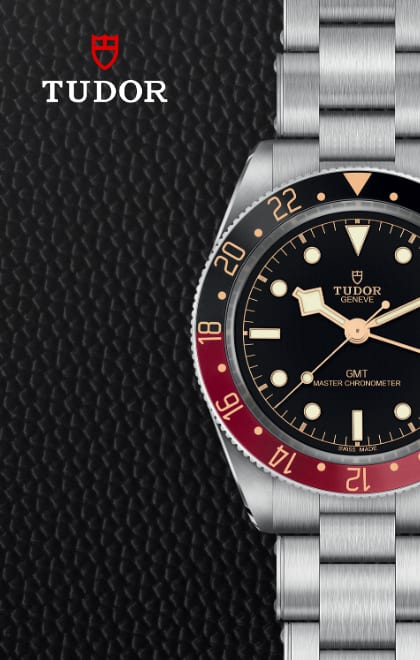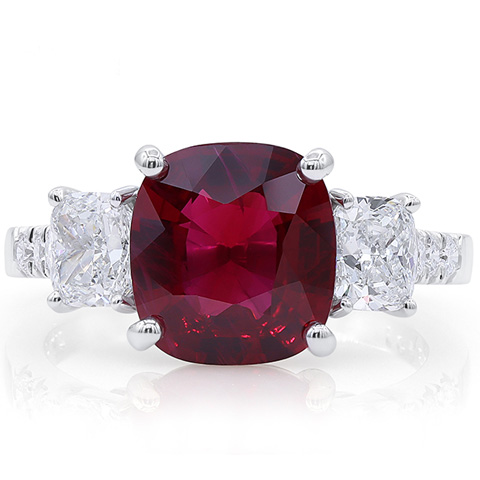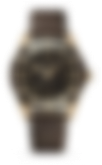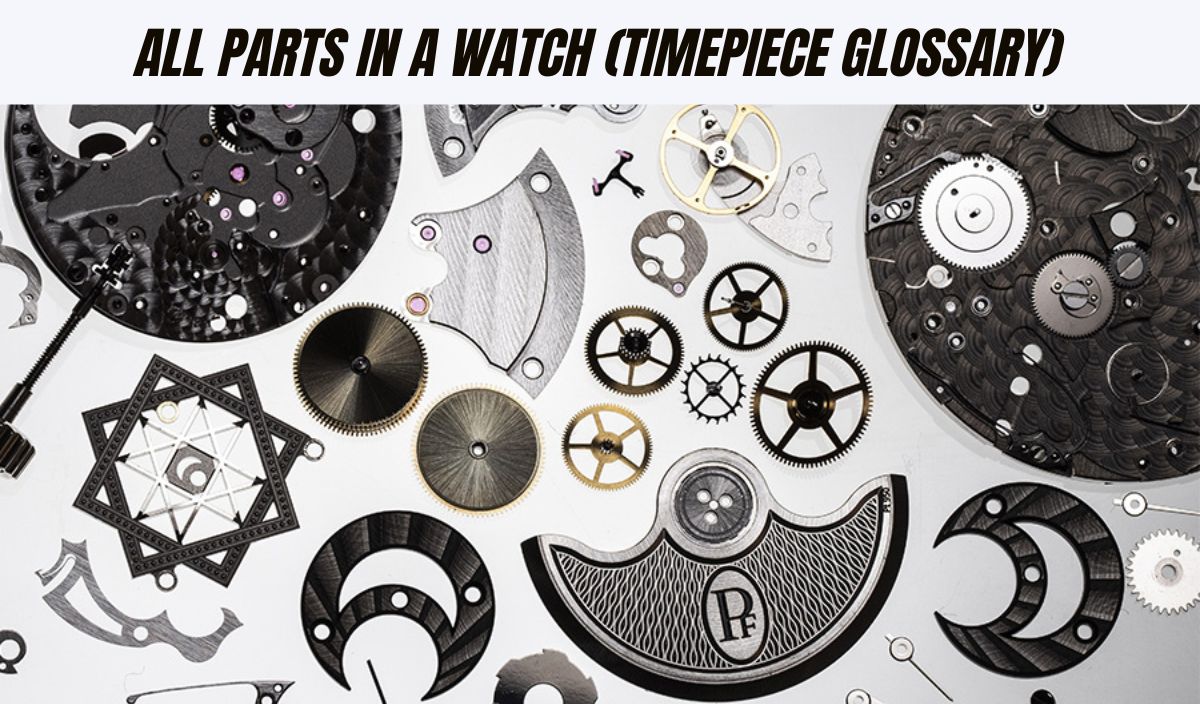
(Timepiece Glossary) ALL Parts in a Watch
There are few documents that can titillate the senses quite like a glossary. Hard not to have your heart pound out of your chest as you excitedly turn the page, waiting to move onto another technical description, full of words you now need to look up just to grasp the full understanding of what you are reading.
THIS is not that glossary! For one, I am not nearly smart enough to write THAT type of glossary, and more importantly, I only have 1500 words to catch your attention, define 14 fundamental aspects of a watch, and wrap a pretty bow on all of it.
Someone once told me that it takes a very smart person to describe a complex subject matter in a simple way that anyone can understand, and I am writing this post with the full intention of proving them wrong!
Why There Are So Many Watch Parts
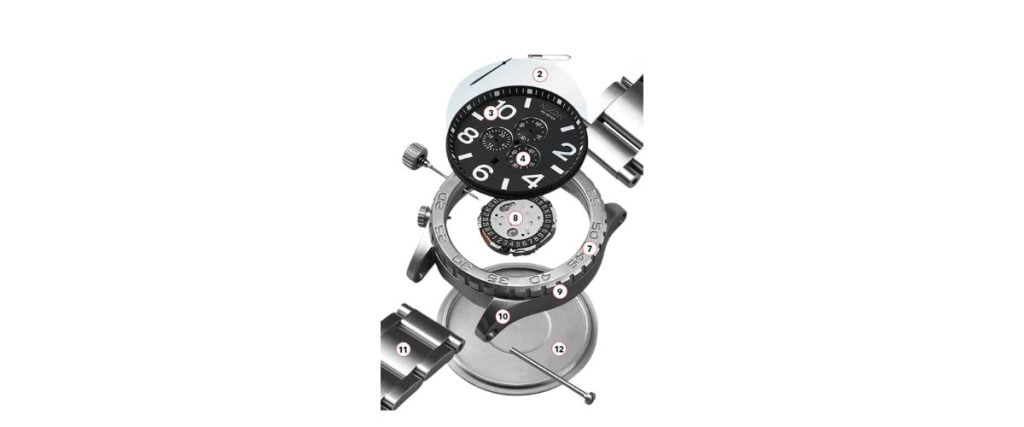
Why is the world of watchmaking so complex? To put it simply, because it can be. One of the aspects of a watch that pulls on our heart strings (and purse strings) the most is complexity.
Does a watch need a chronograph? Nope, but it’s cool! Dive bezel? Nope, but we sure do love them! At the end of the day, these tiny mechanical marvels on our wrist earn our hard-earned watch enthusiast dollars because of their complexity, whether it is how the dial plays with the hands or how the minute repeater helps us flex to our watch nerd friends.
All Watch Parts Explained
Let’s take a look at 14 of the basic components of a timepiece as I try my very best to keep it brief.
Case
The case of a watch is the component that houses the dial and movement of the timepiece. It can be made of an almost limitless variety of materials, although stainless steel is by far the most common. The case provides the structural rigidity of the watch and helps to aid in the robustness of the timepiece.
Caseback
Working in conjunction with the case, the caseback seals up the back of the watch and protects the movement. The caseback is generally made of the same material as the case, but a sapphire crystal has become a popular style, allowing the user to enjoy the view of their new mechanical marvel in action.
There are different ways for a caseback to attach to the case, with more basic watches utilizing a pressure fit, or snap-on, mechanism, while more robust watches utilize a screw-on method to help aid the water resistance.
Bezel
Almost every watch has a bezel, but there are 2 different types. The first is a plain bezel. This style of bezel almost appears to be a continuation of the case but is removed while replacing the crystal. The second type of bezel is a functional bezel.
These bezels vary in function, with the divers style being the most popular, followed by the 12-hour GMT and Tachymeter scale for a chronograph. These bezels, whether fixed or rotating, serve a function for the timepiece.
Bezel Insert
If you have a functional bezel on your watch, it is very likely that you have a bezel insert. This insert is a replaceable component that provides the information that gives the bezel its functionality.
This could be the 60-minute countdown scale on a dive bezel or the 12-hour markers for a GMT. These come in several different materials, with aluminum bezel inserts prevalent on watches prior to the 2010s and more durable ceramic bezels becoming a staple of both luxury and spec monsters alike.
Lugs
The lugs of the watch are what connect the case of the watch to the strap or bracelet. Although some watches have a lugless design, such as the ever-popular Apple Watch, most watches utilize lugs in their design.
Although many consider lugs to simply be an aspect of the watch case, they deserve some attention as their own element. Watch lugs can strongly influence the wearing experience of your timepiece. A small diameter watch with long lugs will wear much larger than the case dimension suggests, think Nomos, while the opposite is also true, think Seiko.
Crown
The crown of the watch is often the part that we interact with the most on our timepiece. Often composed of the same material as the case, the crown is our direct connection to the watch movement via a watch stem.
The crown presents itself as a small bump, often shaped like a crown with ridges, that will hang over the edge of the case. By pulling the crown, you will be able to set the time and, depending on the movement powering your watch, provide power to the movement of your watch.
Crystal
The crystal of a watch is our window to the dial, allowing us to tell the time. These are made of several transparent materials such as mineral glass on less expensive watches, sapphire on modern higher-end watches, or plexiglass on vintage or vintage-inspired watches.
All of these materials have their different benefits, but they all serve the same purpose of allowing us to actually see the time while simultaneously protecting the dial from dust, debris, and impact (damn doorknobs!).
Dial
The dial of the watch is the plate that displays the information of the timepiece. These vary from very simple, such as the Tudor Ranger, to breathtakingly beautiful, such as the Grand Seiko Snowflake. The watch dial is the backdrop to all of the information displayed on the watch, regardless of how simple or complex it is.
Hands
The simplest way to think of watch hands is that they are what tell the time. In reality, it’s not quite that simple. The hands are responsible for giving us information. That information is determined by the regulation of the movement but can come in many forms.
By way of a pinion through the dial to the gears in the movement, the watch hands allow us to see what our watch is actually doing. Hands can vary from basic to beautifully finished and are often a calling card of a given brand or model.
Hour Indices
The hour indices are what give meaning to the hour and minute hands on a dial. These help to mark certain increments of time around the dial and give context to what these hands are actually pointing to. Hour indices can be printed, applied, or even cut out depending on the style of the watch. While applied indices are often sought after, when done right, any style can help elevate a timepiece.
Minute Track
While not present on every watch, a minute track can help to aid in the precision of a timepiece. A minute track follows the circumference of the dial and marks off 1-minute increments. This allows all of us watch nerds to properly set our timepieces to the exact minute as opposed to a guess. While not necessary for a timepiece, these, like the indices, help give further context to what the hands are presenting.
Subdials
More complex watches will feature information beyond just the time. Subdials are a simple way to present additional information to the user. These are generally cut out of the dial, or at least marked with a color change, and will feature their own hands, indices, and markings to help define the information being presented. These can vary from sub seconds counters all the way to chronographs or GMT indicators.
Date Window
Love em or hate em, many watches have a date function on them. This date function allows their user to not only tell the time but the date as well. The date window is a cut out on the dial that allows the date wheel, which is attached to the backside of the movement under the dial, to display itself to the user.
There are few triggers that will set off a watch nerd, I mean enthusiast, like the placement of a date, and is best to avoid bringing up while at watch meetups or in forums.
Strap
The strap is responsible for securing the case of the watch to your wrist. The strap can be integrated, such as the AP Royal Oak, or secured through the lugs. Many sports watches will come fitted with a bracelet composed of the same material as the case, while dress watches often come paired with a custom-crafted piece of leather.
While many people will keep a watch on the original strap, the watch came on for its entire life, one of watch enthusiasm’s great joys comes in the form of swapping from one to another. While I love my watches on their original bracelet, I can’t help but throw them on a NATO strap occasionally.
Conclusion
So there it is; 14 definitions of common watch components. Are watches complex? Absolutely, but you don’t need to know everything about them to have fun. If you are just getting into the hobby, this list here is enough to make you dangerous. Happy watch hunting!
About Exquisite Timepieces
Established in 1998, Exquisite Timepieces is your one-stop shop for all things luxury watches! We are an authorized dealer for 60+ luxury watch brands including Omega, Hublot, Seiko, & Longines! We are proud to showcase one of the world’s largest pre-owned watch collections, including renowned brands like Rolex and Patek Philippe. Check out our brand new watch arrivals here and popular pre-owned listings here.


